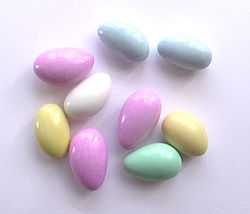Dragée
| Dragée | |
|---|---|
| Confectionery | |
 A form of dragée: Jordan almonds (a.k.a. confetti) | |
| Recipes at Wikibooks: | |
|
| |
| Media at Wikimedia Commons: | |
|
|

A dragée[1] is a bite-sized, colorful form of confectionery with a hard outer shell – which is often used for another purpose (e.g. decorative, symbolic, medicinal, etc.) in addition to consumption purely for enjoyment.
Jordan almonds
A classic form of dragée and comfit, Jordan almonds, also known as mlabas, sugared almonds, confetti, or koufeta[2] consist of almonds which are sugar panned in various pastel colors.[3]
Jordan Almonds are often used as wedding favors; "bitter" almonds and the "sweet" sugar symbolizing bitterness of life and sweetness of love.[4] The treats are often packaged in groups of five to represent happiness, health, longevity, wealth, and fertility.[5][6]
Jordan Almonds are thought to originate in Ancient Rome, where honey-covered almonds were commonly eaten at festivities. When sugar became more readily available in the 15th century, the nuts were coated in sugar instead. In Sulmona, Italy, the technique of creating the dragée almonds was perfected by the Pelino family.[6]
The term "Jordan" is most likely a corrupted version of the French word jardin, meaning "garden," hence, a cultivated rather than wild almond.[7][8] However, others suggest the term referred to a variety of almonds originally grown along the Jordan River characterized by long, thin, slender, rather smooth kernels in thick, heavy shells.[9]
Panned chocolate
Include the Nestlé brand Smarties, multi-colored sugar shells. Other chocolate dragées with multi-colored candy shells include the M&M's, initially designed to allow easy transport and consumption of chocolate for the US Military, have evolved into a popular candy - but are also sold as decorative dragées in 25 different colors.
Medicinal dragées
Used to increase tolerability of bitter medication or merely to compel consumption, medicated candies or sugar coated pills can be referred to as dragées. (e.g. Ayds was a popular weight loss candy in the 1980s.)
Metallic decorative balls

Another form of dragée is a small sphere of sugar, used primarily in the decoration of cookies, cakes, and other forms of bakery. These dragées are produced in various sizes, typically 3 and 4 millimeters in diameter. This is larger than nonpareils and smaller than large pearl tapioca.
Silver dragées have long been used for both wedding and holiday food decoration. More recently, metallic gold, copper, rainbow colors (red, green, blue, etc.), and pearlescent colors have become available.
The U.S. Food and Drug Administration considers the metallic-finish dragées to be inedible, and they are sold with a notice that they are for decorative purposes only. Early in the 20th century, the silver finish may have contained mercury (it no longer does). The sale of these dragées was banned for some time. Although the metallic-finish dragées can be purchased in 49 U.S. states, they are no longer sold in California due to a 2003 lawsuit against several sellers.[10] However, in other countries (including the United Kingdom) they are classified as food items.
See also
- Sprinkles
- Jawbreakers
- Jelly bean
References
- ↑ The word dragée is pronounced /dræˈʒeɪ/ dra-ZHAY; from Greek τραγήματα tragēmata "sweets, treats" (cf. τρώγω "to eat") through Latin tragēmata "sweets" and French la dragée "a sweet with almond filling".
- ↑ Chu, Anita. Field Guide to Candy: How to Identify and Make Virtually Every Candy Imaginable. Philadalphia: Quirk, 2009.
- ↑ E. B. Jackson, ed. (1999). Sugar Confectionery Manufacture (2nd ed.). Springer. p. 251. ISBN 978-0-8342-1297-8.
- ↑ Confetti and Weddings
- ↑ Superior Nut Company. 2010-01-19. The Story of Jordan Almonds. Retrieved 2010-01-28.
- ↑ 6.0 6.1 Chu, Anita. Field Guide to Candy: How to Identify and Make Virtually Every Candy Imaginable. Philadalphia: Quirk, 2009
- ↑ Brewer's Dictionary of Phrase and Fable, 17th edition, 2005, p. 750.
- ↑ The History of The “Confetti of Sulmona” and the Pelino House
- ↑ "CPG Sec. 570.100 Jordan Almonds - Common or Usual Name". Fda.gov. 1941-10-20. Retrieved 2013-01-06.
- ↑ Meisler, Andy (December 18, 2005). "A Tempest on a Tea Cart". The Los Angeles Times.
- Dictionnaire de Français Larousse (1996) ISBN 2-03-320222-4
- Richardson, Tim (2002) Sweets: A History of Candy, Bloomsbury ISBN 1-58234-307-1
- Kings Candy Company - Manufacturers of Jordan Almonds, Candy Coated 'Pee Wee' Licorice and other fine panned confections
| Wikimedia Commons has media related to Dragée. |
| Look up dragée in Wiktionary, the free dictionary. |
| |||||||||||||||||||||||||||||||||||